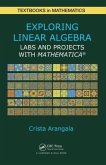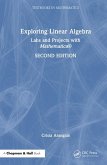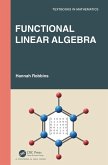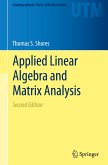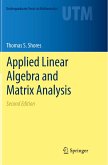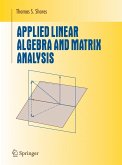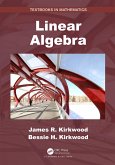- Gebundenes Buch
- Merkliste
- Auf die Merkliste
- Bewerten Bewerten
- Teilen
- Produkt teilen
- Produkterinnerung
- Produkterinnerung
This book is written to give instructors a tool to teach students to develop a mathematical concept from first principles. The text is organized around and offers the standard topics expected in a first undergraduate course in linear algebra.
Andere Kunden interessierten sich auch für
![Exploring Linear Algebra Exploring Linear Algebra]() Crista ArangalaExploring Linear Algebra123,99 €
Crista ArangalaExploring Linear Algebra123,99 €![Exploring Linear Algebra Exploring Linear Algebra]() Crista ArangalaExploring Linear Algebra144,99 €
Crista ArangalaExploring Linear Algebra144,99 €![Functional Linear Algebra Functional Linear Algebra]() Hannah RobbinsFunctional Linear Algebra119,99 €
Hannah RobbinsFunctional Linear Algebra119,99 €![Applied Linear Algebra and Matrix Analysis Applied Linear Algebra and Matrix Analysis]() Thomas S. ShoresApplied Linear Algebra and Matrix Analysis41,99 €
Thomas S. ShoresApplied Linear Algebra and Matrix Analysis41,99 €![Applied Linear Algebra and Matrix Analysis Applied Linear Algebra and Matrix Analysis]() Thomas S. ShoresApplied Linear Algebra and Matrix Analysis40,99 €
Thomas S. ShoresApplied Linear Algebra and Matrix Analysis40,99 €![Applied Linear Algebra and Matrix Analysis Applied Linear Algebra and Matrix Analysis]() Thomas S. ShoresApplied Linear Algebra and Matrix Analysis38,99 €
Thomas S. ShoresApplied Linear Algebra and Matrix Analysis38,99 €![Linear Algebra Linear Algebra]() James R KirkwoodLinear Algebra115,99 €
James R KirkwoodLinear Algebra115,99 €-
-
-
This book is written to give instructors a tool to teach students to develop a mathematical concept from first principles. The text is organized around and offers the standard topics expected in a first undergraduate course in linear algebra.
Hinweis: Dieser Artikel kann nur an eine deutsche Lieferadresse ausgeliefert werden.
Hinweis: Dieser Artikel kann nur an eine deutsche Lieferadresse ausgeliefert werden.
Produktdetails
- Produktdetails
- Verlag: CRC Press
- Seitenzahl: 357
- Erscheinungstermin: 4. Mai 2021
- Englisch
- Abmessung: 239mm x 152mm x 23mm
- Gewicht: 658g
- ISBN-13: 9780367248963
- ISBN-10: 0367248964
- Artikelnr.: 61649172
- Herstellerkennzeichnung
- Libri GmbH
- Europaallee 1
- 36244 Bad Hersfeld
- gpsr@libri.de
- Verlag: CRC Press
- Seitenzahl: 357
- Erscheinungstermin: 4. Mai 2021
- Englisch
- Abmessung: 239mm x 152mm x 23mm
- Gewicht: 658g
- ISBN-13: 9780367248963
- ISBN-10: 0367248964
- Artikelnr.: 61649172
- Herstellerkennzeichnung
- Libri GmbH
- Europaallee 1
- 36244 Bad Hersfeld
- gpsr@libri.de
Jeff Suzuki is Associate Professor of Mathematics at Brooklyn College and holds a Ph.D. from Boston University. His research interests include mathematics education, history of mathematics, and the application of mathematics to society and technology. He is a two-time winner of the prestigious Carl B. Allendoerfer Award for expository writing. His publications have appeared in The College Mathematics Journals; Mathematics Magazine; Mathematics Teacher; and the American Mathematical Society's blog on teaching and learning mathematics. His YouTube channel (http://youtube.com/jeffsuzuki1) includes videos on mathematical subjects ranging from elementary arithmetic to linear algebra, cryptography, and differential equations.
Introduction and Features. For the Student . . . and Teacher.
Prerequisites. Suggested Sequences. 1. Tuples and Vectors. 1.1. Tuples.
1.2. Vectors. 1.3. Proofs. 1.4. Directed Distances. 1.5. Magnitude. 1.6.
Direction. 1.7. Unit and Orthogonal Vectors. 2. Systems of Linear
Equations. 2.1. Standard Form. 2.2. Solving Systems. 2.3. Coefficient
Matrices. 2.4. Free and Basic Variables. 2.5. Computational Considerations.
2.6. Applications of Linear Algebra. 3. Transformations. 3.1. Geometric
Transformations. 3.2. Vector Transformations. 3.3. The Transformation
Matrix. 3.4. Domain, Codomain, and Range. 3.5. Discrete Time Models. 3.6.
Linear Transformations. 3.7. Transformation Arithmetic. 3.8. Cryptography.
4. Matrix Algebra. 4.1. Scalar Multiplication. 4.2. Matrix Addition. 4.3.
Matrix Multiplication. 4.4. Elementary Matrices. 4.5. More Transformations.
4.6. Matrix Inverses. 4.7. Complex Matrices. 5. Vector Spaces. 5.1. Vector
Spaces. 5.2. Kernels and Null Spaces. 5.3. Span. 5.4. Linear Independence
and Dependence. 5.5. Change of Basis. 5.6. Orthogonal Bases. 5.7. Normed
Vector Spaces. 5.8. Inner Product Spaces. 5.9. Applications. 5.10. Least
Squares. 6. Determinants. 6.1. Linear Equations. 6.2. Transformations. 6.3.
Inverse. 6.4. The Determinant. 6.5. A Formula for the Determinant. 6.6. The
Determinant Formula. 6.7. More Properties of the Determinant. 6.8. More
Computations of the Determinant. 6.9. Use(lesses) of the Determinant. 6.10.
Uses of the Determinant. 6.11. Permutations. 7. Eigenvalues and
Eigenvectors. 7.1. More Transformations. 7.2. The Eigenproblem. 7.3.
Finding Eigenvalues: Numerical Methods. 7.4. Eigenvalues and Eigenvectors
for a 2 x 2 Matrix. 7.5. The Characteristic Equation. 7.6. Stochastic
Matrices. 7.7. A Determinant-Free Approach. 7.8. Generalized Eigenvalues.
7.9. Symmetric Matrices. 7.10. Graphs. 8. Decomposition. 8.1.
LU-Decomposition. 8.2. QR-Decomposition. 8.3. Eigendecompositions. 8.4.
Singular Value Decomposition. 9. Extras. 9.1. Properties of Polynomials.
9.2. Complex Numbers. 9.3. Mod-N Arithmetic. 9.4. Polar Coordinates.
Bibliography. Index.
Prerequisites. Suggested Sequences. 1. Tuples and Vectors. 1.1. Tuples.
1.2. Vectors. 1.3. Proofs. 1.4. Directed Distances. 1.5. Magnitude. 1.6.
Direction. 1.7. Unit and Orthogonal Vectors. 2. Systems of Linear
Equations. 2.1. Standard Form. 2.2. Solving Systems. 2.3. Coefficient
Matrices. 2.4. Free and Basic Variables. 2.5. Computational Considerations.
2.6. Applications of Linear Algebra. 3. Transformations. 3.1. Geometric
Transformations. 3.2. Vector Transformations. 3.3. The Transformation
Matrix. 3.4. Domain, Codomain, and Range. 3.5. Discrete Time Models. 3.6.
Linear Transformations. 3.7. Transformation Arithmetic. 3.8. Cryptography.
4. Matrix Algebra. 4.1. Scalar Multiplication. 4.2. Matrix Addition. 4.3.
Matrix Multiplication. 4.4. Elementary Matrices. 4.5. More Transformations.
4.6. Matrix Inverses. 4.7. Complex Matrices. 5. Vector Spaces. 5.1. Vector
Spaces. 5.2. Kernels and Null Spaces. 5.3. Span. 5.4. Linear Independence
and Dependence. 5.5. Change of Basis. 5.6. Orthogonal Bases. 5.7. Normed
Vector Spaces. 5.8. Inner Product Spaces. 5.9. Applications. 5.10. Least
Squares. 6. Determinants. 6.1. Linear Equations. 6.2. Transformations. 6.3.
Inverse. 6.4. The Determinant. 6.5. A Formula for the Determinant. 6.6. The
Determinant Formula. 6.7. More Properties of the Determinant. 6.8. More
Computations of the Determinant. 6.9. Use(lesses) of the Determinant. 6.10.
Uses of the Determinant. 6.11. Permutations. 7. Eigenvalues and
Eigenvectors. 7.1. More Transformations. 7.2. The Eigenproblem. 7.3.
Finding Eigenvalues: Numerical Methods. 7.4. Eigenvalues and Eigenvectors
for a 2 x 2 Matrix. 7.5. The Characteristic Equation. 7.6. Stochastic
Matrices. 7.7. A Determinant-Free Approach. 7.8. Generalized Eigenvalues.
7.9. Symmetric Matrices. 7.10. Graphs. 8. Decomposition. 8.1.
LU-Decomposition. 8.2. QR-Decomposition. 8.3. Eigendecompositions. 8.4.
Singular Value Decomposition. 9. Extras. 9.1. Properties of Polynomials.
9.2. Complex Numbers. 9.3. Mod-N Arithmetic. 9.4. Polar Coordinates.
Bibliography. Index.
Introduction and Features. For the Student . . . and Teacher. Prerequisites. Suggested Sequences. 1. Tuples and Vectors. 1.1. Tuples. 1.2. Vectors. 1.3. Proofs. 1.4. Directed Distances. 1.5. Magnitude. 1.6. Direction. 1.7. Unit and Orthogonal Vectors. 2. Systems of Linear Equations. 2.1. Standard Form. 2.2. Solving Systems. 2.3. Coefficient Matrices. 2.4. Free and Basic Variables. 2.5. Computational Considerations. 2.6. Applications of Linear Algebra. 3. Transformations. 3.1. Geometric Transformations. 3.2. Vector Transformations. 3.3. The Transformation Matrix. 3.4. Domain, Codomain, and Range. 3.5. Discrete Time Models. 3.6. Linear Transformations. 3.7. Transformation Arithmetic. 3.8. Cryptography. 4. Matrix Algebra. 4.1. Scalar Multiplication. 4.2. Matrix Addition. 4.3. Matrix Multiplication. 4.4. Elementary Matrices. 4.5. More Transformations. 4.6. Matrix Inverses. 4.7. Complex Matrices. 5. Vector Spaces. 5.1. Vector Spaces. 5.2. Kernels and Null Spaces. 5.3. Span. 5.4. Linear Independence and Dependence. 5.5. Change of Basis. 5.6. Orthogonal Bases. 5.7. Normed Vector Spaces. 5.8. Inner Product Spaces. 5.9. Applications. 5.10. Least Squares. 6. Determinants. 6.1. Linear Equations. 6.2. Transformations. 6.3. Inverse. 6.4. The Determinant. 6.5. A Formula for the Determinant. 6.6. The Determinant Formula. 6.7. More Properties of the Determinant. 6.8. More Computations of the Determinant. 6.9. Use(lesses) of the Determinant. 6.10. Uses of the Determinant. 6.11. Permutations. 7. Eigenvalues and Eigenvectors. 7.1. More Transformations. 7.2. The Eigenproblem. 7.3. Finding Eigenvalues: Numerical Methods. 7.4. Eigenvalues and Eigenvectors for a 2 x 2 Matrix. 7.5. The Characteristic Equation. 7.6. Stochastic Matrices. 7.7. A Determinant-Free Approach. 7.8. Generalized Eigenvalues. 7.9. Symmetric Matrices. 7.10. Graphs. 8. Decomposition. 8.1. LU-Decomposition. 8.2. QR-Decomposition. 8.3. Eigendecompositions. 8.4. Singular Value Decomposition. 9. Extras. 9.1. Properties of Polynomials. 9.2. Complex Numbers. 9.3. Mod-N Arithmetic. 9.4. Polar Coordinates. Bibliography. Index.
Introduction and Features. For the Student . . . and Teacher.
Prerequisites. Suggested Sequences. 1. Tuples and Vectors. 1.1. Tuples.
1.2. Vectors. 1.3. Proofs. 1.4. Directed Distances. 1.5. Magnitude. 1.6.
Direction. 1.7. Unit and Orthogonal Vectors. 2. Systems of Linear
Equations. 2.1. Standard Form. 2.2. Solving Systems. 2.3. Coefficient
Matrices. 2.4. Free and Basic Variables. 2.5. Computational Considerations.
2.6. Applications of Linear Algebra. 3. Transformations. 3.1. Geometric
Transformations. 3.2. Vector Transformations. 3.3. The Transformation
Matrix. 3.4. Domain, Codomain, and Range. 3.5. Discrete Time Models. 3.6.
Linear Transformations. 3.7. Transformation Arithmetic. 3.8. Cryptography.
4. Matrix Algebra. 4.1. Scalar Multiplication. 4.2. Matrix Addition. 4.3.
Matrix Multiplication. 4.4. Elementary Matrices. 4.5. More Transformations.
4.6. Matrix Inverses. 4.7. Complex Matrices. 5. Vector Spaces. 5.1. Vector
Spaces. 5.2. Kernels and Null Spaces. 5.3. Span. 5.4. Linear Independence
and Dependence. 5.5. Change of Basis. 5.6. Orthogonal Bases. 5.7. Normed
Vector Spaces. 5.8. Inner Product Spaces. 5.9. Applications. 5.10. Least
Squares. 6. Determinants. 6.1. Linear Equations. 6.2. Transformations. 6.3.
Inverse. 6.4. The Determinant. 6.5. A Formula for the Determinant. 6.6. The
Determinant Formula. 6.7. More Properties of the Determinant. 6.8. More
Computations of the Determinant. 6.9. Use(lesses) of the Determinant. 6.10.
Uses of the Determinant. 6.11. Permutations. 7. Eigenvalues and
Eigenvectors. 7.1. More Transformations. 7.2. The Eigenproblem. 7.3.
Finding Eigenvalues: Numerical Methods. 7.4. Eigenvalues and Eigenvectors
for a 2 x 2 Matrix. 7.5. The Characteristic Equation. 7.6. Stochastic
Matrices. 7.7. A Determinant-Free Approach. 7.8. Generalized Eigenvalues.
7.9. Symmetric Matrices. 7.10. Graphs. 8. Decomposition. 8.1.
LU-Decomposition. 8.2. QR-Decomposition. 8.3. Eigendecompositions. 8.4.
Singular Value Decomposition. 9. Extras. 9.1. Properties of Polynomials.
9.2. Complex Numbers. 9.3. Mod-N Arithmetic. 9.4. Polar Coordinates.
Bibliography. Index.
Prerequisites. Suggested Sequences. 1. Tuples and Vectors. 1.1. Tuples.
1.2. Vectors. 1.3. Proofs. 1.4. Directed Distances. 1.5. Magnitude. 1.6.
Direction. 1.7. Unit and Orthogonal Vectors. 2. Systems of Linear
Equations. 2.1. Standard Form. 2.2. Solving Systems. 2.3. Coefficient
Matrices. 2.4. Free and Basic Variables. 2.5. Computational Considerations.
2.6. Applications of Linear Algebra. 3. Transformations. 3.1. Geometric
Transformations. 3.2. Vector Transformations. 3.3. The Transformation
Matrix. 3.4. Domain, Codomain, and Range. 3.5. Discrete Time Models. 3.6.
Linear Transformations. 3.7. Transformation Arithmetic. 3.8. Cryptography.
4. Matrix Algebra. 4.1. Scalar Multiplication. 4.2. Matrix Addition. 4.3.
Matrix Multiplication. 4.4. Elementary Matrices. 4.5. More Transformations.
4.6. Matrix Inverses. 4.7. Complex Matrices. 5. Vector Spaces. 5.1. Vector
Spaces. 5.2. Kernels and Null Spaces. 5.3. Span. 5.4. Linear Independence
and Dependence. 5.5. Change of Basis. 5.6. Orthogonal Bases. 5.7. Normed
Vector Spaces. 5.8. Inner Product Spaces. 5.9. Applications. 5.10. Least
Squares. 6. Determinants. 6.1. Linear Equations. 6.2. Transformations. 6.3.
Inverse. 6.4. The Determinant. 6.5. A Formula for the Determinant. 6.6. The
Determinant Formula. 6.7. More Properties of the Determinant. 6.8. More
Computations of the Determinant. 6.9. Use(lesses) of the Determinant. 6.10.
Uses of the Determinant. 6.11. Permutations. 7. Eigenvalues and
Eigenvectors. 7.1. More Transformations. 7.2. The Eigenproblem. 7.3.
Finding Eigenvalues: Numerical Methods. 7.4. Eigenvalues and Eigenvectors
for a 2 x 2 Matrix. 7.5. The Characteristic Equation. 7.6. Stochastic
Matrices. 7.7. A Determinant-Free Approach. 7.8. Generalized Eigenvalues.
7.9. Symmetric Matrices. 7.10. Graphs. 8. Decomposition. 8.1.
LU-Decomposition. 8.2. QR-Decomposition. 8.3. Eigendecompositions. 8.4.
Singular Value Decomposition. 9. Extras. 9.1. Properties of Polynomials.
9.2. Complex Numbers. 9.3. Mod-N Arithmetic. 9.4. Polar Coordinates.
Bibliography. Index.
Introduction and Features. For the Student . . . and Teacher. Prerequisites. Suggested Sequences. 1. Tuples and Vectors. 1.1. Tuples. 1.2. Vectors. 1.3. Proofs. 1.4. Directed Distances. 1.5. Magnitude. 1.6. Direction. 1.7. Unit and Orthogonal Vectors. 2. Systems of Linear Equations. 2.1. Standard Form. 2.2. Solving Systems. 2.3. Coefficient Matrices. 2.4. Free and Basic Variables. 2.5. Computational Considerations. 2.6. Applications of Linear Algebra. 3. Transformations. 3.1. Geometric Transformations. 3.2. Vector Transformations. 3.3. The Transformation Matrix. 3.4. Domain, Codomain, and Range. 3.5. Discrete Time Models. 3.6. Linear Transformations. 3.7. Transformation Arithmetic. 3.8. Cryptography. 4. Matrix Algebra. 4.1. Scalar Multiplication. 4.2. Matrix Addition. 4.3. Matrix Multiplication. 4.4. Elementary Matrices. 4.5. More Transformations. 4.6. Matrix Inverses. 4.7. Complex Matrices. 5. Vector Spaces. 5.1. Vector Spaces. 5.2. Kernels and Null Spaces. 5.3. Span. 5.4. Linear Independence and Dependence. 5.5. Change of Basis. 5.6. Orthogonal Bases. 5.7. Normed Vector Spaces. 5.8. Inner Product Spaces. 5.9. Applications. 5.10. Least Squares. 6. Determinants. 6.1. Linear Equations. 6.2. Transformations. 6.3. Inverse. 6.4. The Determinant. 6.5. A Formula for the Determinant. 6.6. The Determinant Formula. 6.7. More Properties of the Determinant. 6.8. More Computations of the Determinant. 6.9. Use(lesses) of the Determinant. 6.10. Uses of the Determinant. 6.11. Permutations. 7. Eigenvalues and Eigenvectors. 7.1. More Transformations. 7.2. The Eigenproblem. 7.3. Finding Eigenvalues: Numerical Methods. 7.4. Eigenvalues and Eigenvectors for a 2 x 2 Matrix. 7.5. The Characteristic Equation. 7.6. Stochastic Matrices. 7.7. A Determinant-Free Approach. 7.8. Generalized Eigenvalues. 7.9. Symmetric Matrices. 7.10. Graphs. 8. Decomposition. 8.1. LU-Decomposition. 8.2. QR-Decomposition. 8.3. Eigendecompositions. 8.4. Singular Value Decomposition. 9. Extras. 9.1. Properties of Polynomials. 9.2. Complex Numbers. 9.3. Mod-N Arithmetic. 9.4. Polar Coordinates. Bibliography. Index.


